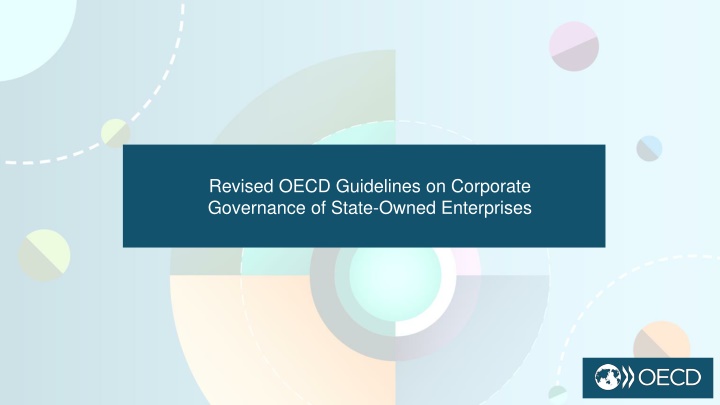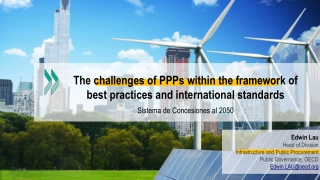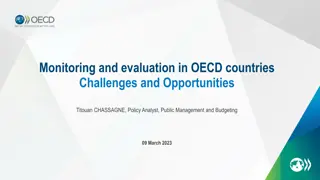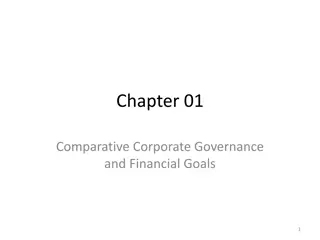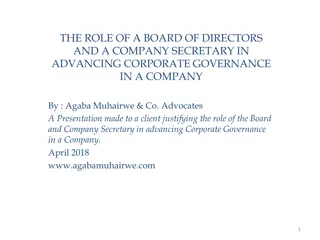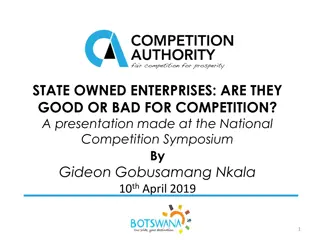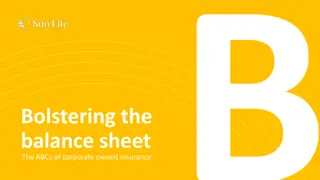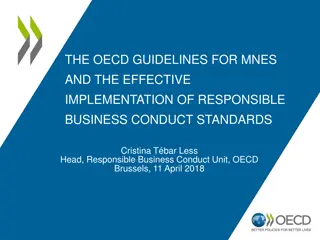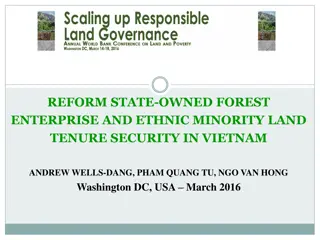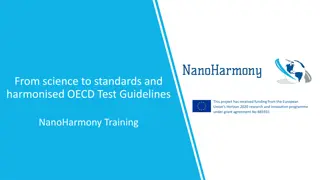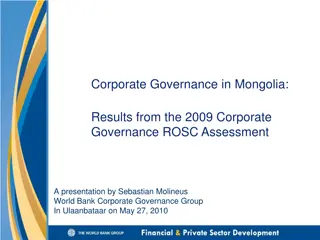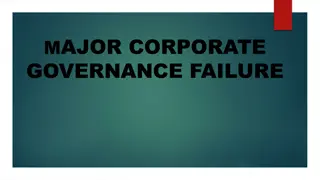Revised OECD Guidelines on Corporate Governance of State-Owned Enterprises
Leading global standard on ownership and governance of state-owned enterprises, addressing policy makers to improve SOE performance, efficiency, and transparency. The 2024 edition provides comparative data on the implementation of the guidelines and covers key aspects such as professional ownership, transparency, board responsibilities, and sustainability.
Download Presentation

Please find below an Image/Link to download the presentation.
The content on the website is provided AS IS for your information and personal use only. It may not be sold, licensed, or shared on other websites without obtaining consent from the author.If you encounter any issues during the download, it is possible that the publisher has removed the file from their server.
You are allowed to download the files provided on this website for personal or commercial use, subject to the condition that they are used lawfully. All files are the property of their respective owners.
The content on the website is provided AS IS for your information and personal use only. It may not be sold, licensed, or shared on other websites without obtaining consent from the author.
E N D
Presentation Transcript
Revised OECD Guidelines on Corporate Governance of State-Owned Enterprises
OECD Guidelines on Corporate Governance of State-Owned Enterprises Leading global standard on ownership and governance of state-owned enterprise (SOEs). Addressed to policy makers to improve SOE performance, efficiency and transparency. Adopted in 2005, revised in 2015 and 2024. 42 adherents. OECD members, EU and three partner economies. Applicable to: all SOEs, including state-owned financial institutions and SOEs held at the sub-national level. all government institutions responsible for SOE ownership, oversight or control. While ensuring for flexibility and proportionality depending on the size, sector and ownership structure of SOEs. 2
2024 edition of Ownership and Governance of SOEs Rich source of comparative data on the implementation of the SOE Guidelines. Covering 59 jurisdictions. Five chapters on: Professional and active SOE ownership Ensuring a level playing field Disclosure, transparency and accountability of SOEs Composition and responsibilities of boards Sustainability and state ownership 3
Growing role of SOEs in the global marketplace (1) Among top 500 global companies by revenue, the share of SOEs has increased four times since 2000 Nearly two thirds of the largest SOEs are in capital and GHG intensive sectors Number of SOEs in the largest 500 companies Number of SOEs in the largest 500 companies Distribution by industry Distribution by industry Petroleum Refining 15% 140 126 120 Others 33% 102 100 Mining, Crude-Oil Production 13% 80 60 34 40 20 Utilities 9% 0 2000 2017 2023 Metals 6% Engineering & Construction 9% Energy 7% Banks: Commercial and Savings 8% 4 Source: OECD (2024), Ownership and Governance of State-Owned Enterprises, Fortune Global 500.
Growing role of SOEs in the global marketplace (2) The public sector is a large shareholder in global public equity markets Share of market capitalisation of listed companies where public sector ownership is significant (over 25%) Share of market capitalisation of listed companies where public sector ownership is significant (over 25%) 2023, by region 2023, by region Notes: Asia excl. CN&JP = Asia excluding China and Japan. LAC = Latin America and the Caribbean. The public sector refers to direct ownership by central governments, local governments, public pension funds, SOEs and sovereign wealth funds (SWFs), hence the data presented in this section do not correspond strictly to the definition of SOEs as put forward in the OECDGuidelines on Corporate Governance of State- Owned Enterprises. Source: OECD (2024), Ownership and Governance of State-Owned Enterprises, OECD Capital Market Series dataset, FactSet, LSEG, Bloomberg. 5
Key objectives of the revision of the SOE Guidelines Reflect evolving best practices and key developments over the past decade. Ensure complementarity with: G20/OECD Principles of Corporate Governance (revised in 2023). OECD Guidelines on Anti-Corruption and Integrity in SOEs. Priority areas: 1. Strengthening the state ownership framework by ensuring active and professional ownership. 2. Maintaining a level playing field when SOEs compete in the marketplace. 3. Improving corporate governance frameworks for SOEs, including integrity, transparency and disclosure. 4. Leading by example on sustainability and responsible business conduct. 6
Strengthening the state ownership framework Ensuring that the state is an informed, professional and active owner, that SOE governance is carried out transparently and accountably, and based on clearly defined rationales and expectations. 53% of jurisdictions have a centralised or co-ordinated ownership. 53% of jurisdictions outline the state s goal as an owner and how it exercises ownership. 64% of jurisdictions publish annual reports on their SOE portfolio. Revisions and new recommendations Define ownership arrangements and stress the need for a whole-of government approach when ownership is exercised by multiple ministries or departments. Clarify the definition of ownership or control, including how control may be exercised and the exercise of ownershipwithin SOE corporate groups. Recommend that when the government redefines SOE objectives, it does so in a transparent manner. Highlight the role of the state in monitoring fiscal risks that might arise from SOE activities. 7
Maintaining a level playing field Strengthening legal, regulatory and policy frameworks for SOEs maintaining a level playing field and fair competition in the marketplace when SOEs engage in economic activities and ensuring equitable treatment of all shareholders. 36% jurisdictions allow some SOEs to benefit from special tax treatment. 45% jurisdictions require structural or at least accounting separation of public service obligations from other activities. 74% of SOEs may benefit from indirect financial support not available to competitors. Revisions and new recommendations Emphasise the importance of proportionate and transparent compensation for SOEs carrying out public service obligations. Discourage the use of SOEs to subsidise or grant advantages to other commercial undertakings. Clarify the scope of advantages provided to and via SOEs. Encourage SOEs to act with commercial considerations intheir economic activities. 8
Improving corporate governance frameworks for SOEs Ensuring that SOEs observe high standards of integrity, transparency, disclosure and accountability towards shareholders and stakeholders, and that boards have the necessary competencies and objectivity to carry out their functions. 51% of jurisdictions subject SOEs to independent 55% require disclosure for non-listed SOEs as applicable to listed companies. 25% of jurisdictions do not have a formal politicians serving on boards even if it may not occur in practice. Only two jurisdictions define board member independence in line with benchmark definition. external ban on audits, and the OECD Revisions and new recommendations Clarify board s responsibilities for risk management, and internal and external audit and controls. Strengthen provisions promoting board diversity, autonomy and independence. Update the definition of independent board member. Clarify the duties and responsibilities of boards, including taking into account stakeholder interests. 9
Leading by example on sustainability Addressing how state owners can lead by example by integrating sustainability considerations in their ownership policies and practices and that of their SOEs,while ensuring that they uphold high standards of integrity and responsible business conduct, taking into account stakeholders interests. The public sector is a significant shareholder in one fifth of the 100 highest GHG-emitting listed companies. But only 26% of jurisdictions integrate climate goals in their ownership policies. 92% of a sample of 479 listed SOEs disclosed sustainability information in 2022. 51% disclosed scope 1 and 2 GHG emissions and 23% disclosed scope 3 emissions. Revisions and new recommendations Highlight the importance of including sustainability goals in the state s ownership policy and practices. Clarify the role of SOE boards in considering sustainability risks and opportunities when fulfilling their key functions. Underline the expectations for sustainability reporting and disclosure requirements based on consistent, comparable and reliable information. Encourage the state to set high expectations that SOEs observe responsible business conduct standards, and act responsibly towards stakeholders, including employees. 10
Thank you for your attention! Please scan for more information. 11
